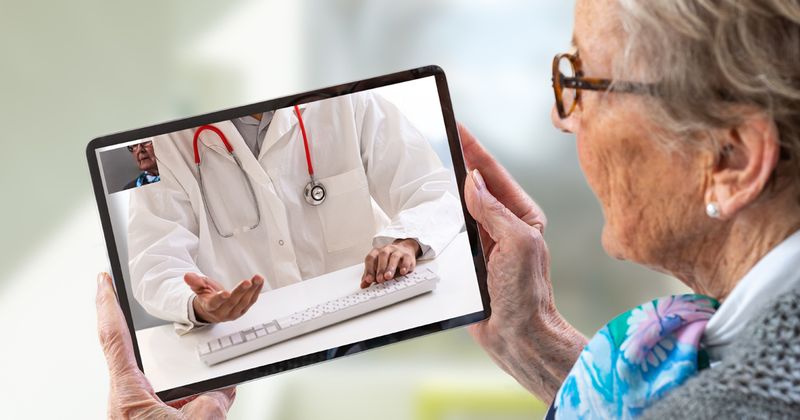Mobile health technology may improve secondary CVD prevention in older adults
Implementing effective mobile health technology will be key for secondary CVD prevention in older adults in the future, according to a scientific statement from the American Heart Association.
Published in Circulation: Cardiovascular Quality and Outcomes, the review document outlines how mobile health technology, such as text messaging, wearable technology and telehealth interventions, could improve health behaviors and medication adherence among older patients with CVD.

“‘Wellness’ and ‘wellness tech’ are having a moment. Over the last decade, mobile health technology, especially the wearable technology and mobile applications markets, have grown substantially,” Erica N. Schorr, PhD, BSBA, RN, FAHA, associate professor in the Adult and Gerontological Health Cooperative at the University of Minnesota School of Nursing and chair of the statement writing committee, told Healio. “Additionally, people are paying closer attention to what goes into and onto their bodies, and how little or how much they are moving them. As a result, an entire industry has developed that clinicians can leverage to help patients optimize their CV health.
“Our scientific statement highlights the potential benefit that mobile health interventions can provide for monitoring, prompting, encouraging, and education older adults with CVD who are prone to adverse events such as polypharmacy, comorbid conditions and functional declines,” Schorr told Healio.
Improving physical activity, medication adherence
Physical inactivity is highest among individuals aged 65 years or older, especially among those with CVD. According to the statement, challenges associated with initiating and maintaining physical activity in this population may be associated with heterogeneity in perceived barriers and motivators based on older age categories and sex.
Schorr and colleagues wrote that targeted mobile health strategies have improved health behaviors in older adults with CVD.
For example, in the Text4Heart study, bidirectional text messaging plus a website-based intervention improved behavior such as smoking cessation, fruit and vegetable consumption, alcohol consumption and physical activity compared with a control group (adjusted OR = 2.55; 95% CI, 1.12-5.84); however, the between group difference was no longer significant at 6 months (aOR = 1.93; 95% CI, 0.83-4.53).
In the HEART study, three to five text messages per week plus a website-based intervention increased leisure-time physical activity (110 minutes per week) and walking (151 minutes per week) compared with usual care.
In two other trials that included wearables technology, researchers observed improvements in peak maximal oxygen consumption (VO2) and increased moderate to vigorous physical activity among patients with peripheral artery disease and after cardiac rehabilitation. In both studies, the intervention included self-monitoring and personalized coaching via telephone or mobile app, with feedback.
“Nonadherence to medical therapy is a significant barrier to CVD risk factor optimization,” the researchers wrote. “Using mHealth technology significantly improves medication adherence.”
The statement highlighted eight trials that examined the effect of mobile health interventions on medication adherence.
According to the statement, all trials that involved text message-based interventions increased self-reported medication adherence, and two of three app-based intervention studies improved adherence, suggesting that similarly styled intervention may improve noncompliance associated with forgetfulness or cognitive impairment.
Another trial that assessed standardized educational text messages for patients with decompensated congestive HF reduced hospital readmissions and improved event-free survival.
Ease of use, patient satisfaction
“The first step to increasing patient use is to engage in a conversation and assess each patient individually, the same way we perform any other health assessments,” Schorr told Healio. “Before making specific recommendations, we need to know what mobile technology a patient currently owns and if a technology is being used to monitor health (eg, sleep, physical activity, BP, blood sugar, medication reminders, etc). Based on the patient’s current health status, shared goals can be created and mobile technologies can be leveraged to assist patients in monitoring, prompting, encouraging and educating adults with CVD who are prone to adverse events such as polypharmacy, comorbid conditions and functional declines.”
Among all intervention studies that documented outcomes related to patient experience included in this review, usability, satisfaction and acceptance of mobile health interventions were generally high.
The committee reported that studies with app-only interventions, the more than 60% of participants reported ease of use and found the app helpful; however, many of the apps were intended for a specific subset of patients, of which there were too few, limiting the external validity.
A cross-sectional study of older patients with HF demonstrated that perceived ease of use and usefulness were associated with greater intention to use mobile health technology, according to the statement.
Moreover, interventions with text messaging tended to report high-user engagement.
“The pandemic has highlighted the importance of self-management of health and chronic conditions for clinicians and patients,” Schorr told Healio. “Mobile health technologies can be leveraged to provide individuals with continuous and individualized feedback and guidance on specific health measures such as medications, blood glucose control and levels of physical activity. These tools can foster awareness and management of health conditions and create a level of self-accountability and self-responsibility that might not otherwise exist for some individuals. Patients can then share mobile health data summaries with their providers of health parameters that are of particular interest over a period of weeks or months. These data can give a provider insight into a patients’ day-to-day health status, instead of just the brief snapshot obtained during an office visit, and guide the recommendations provided to each patient.”
For more information:
Erica N. Schorr, PhD, BSBA, RN, FAHA, can be reached at scho0828@umn.edu.

